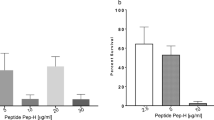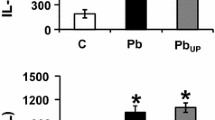Abstract
The biochemical mechanism of action of human neutrophil peptide-1 (HNP-1) against Mycobacterium tuberculosis H37Ra was studied. Mycobacteria grown in the presence of a subinhibitory concentration (IC50) of HNP-1 showed a significant decrease in the biosynthesis of vital macromolecules, as shown by the incorporation of various radiolabeled precursors. Mycobacterial cells grown in the presence of HNP-1 exhibited surface changes, as was evident from the increased number of binding sites for l-anilinonaphthalene 8-sulfonate. Permeability studies carried out with spheroplasts showed a significantly high permeability to a fluorescent probe, N-phenyl naphthylamine, in the presence of HNP-1. Significant changes in the cell wall and cell membrane were observed when HNP-1-grown cells were analysed by transmission electron microscopy. Our results suggest the mycobacterial cell wall/membrane to be the major target(s) of HNP-1.
Similar content being viewed by others
Author information
Authors and Affiliations
Additional information
Received: 7 January 1999 / Accepted: 15 February 1999
Rights and permissions
About this article
Cite this article
Sharma, S., Verma, I. & Khuller, G. Biochemical interaction of human neutrophil peptide-1 with Mycobacterium tuberculosis H37Ra. Arch Microbiol 171, 338–342 (1999). https://doi.org/10.1007/s002030050719
Issue Date:
DOI: https://doi.org/10.1007/s002030050719




